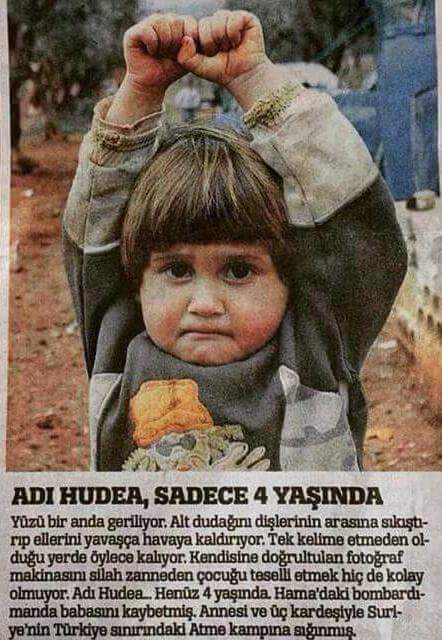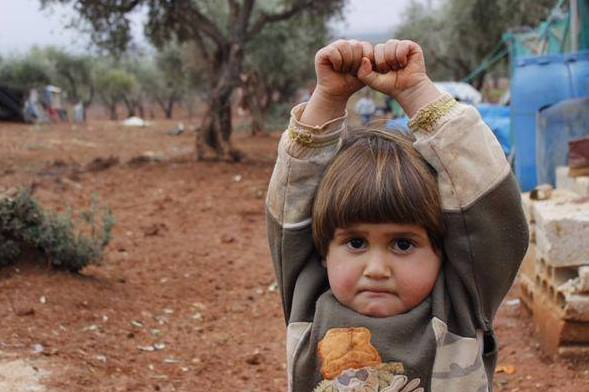BLACKEAGLE
SENIOR MEMBER
She was clearly a child of war. Against a backdrop of broken cement bricks and the dirt ground, the 4-year-old clenched her tiny hands above her head, pursed her lips and trained her eyes —a seemingly bottomless well of sadness and innocence — at the man pointing a large camera at her face.
In that moment, in late 2014 at a Syrian refugee camp, she was immortalized as a symbol of the human toll that endless war and strife have taken on Syria's displaced millions. The photo of Hudea was published in January by the Turkish newspaper Türkiye, according to the BBC, and in the non-English language social media world, it went viral.

The photo recently began circulating on social media again, this time among English-language users. Some believed that the child was a boy (she is a girl whose tawny brown hair had been cut short), and others speculated that the photo was taken in 2012.
When it was tweeted out by Gaza-based photographer Nadia Abu Shaban — who herself didn't know where it came from or who had taken it, according to the BBC — it was retweeted more than 16,000 times. Many who commented or shared the photo characterized the child's gesture as a form of "surrender."

Nadia AbuShaban @NadiaAbuShaban Follow
photojournalist took this photo 4 Syrian child, thought he has a weapon not a camera so she Gave up ! #Surrended
10:54 PM - 24 Mar 2015
By Abby Phillip March 31 at 1:24 PM
She was clearly a child of war. Against a backdrop of broken cement bricks and the dirt ground, the 4-year-old clenched her tiny hands above her head, pursed her lips and trained her eyes —a seemingly bottomless well of sadness and innocence — at the man pointing a large camera at her face.
In that moment, in late 2014 at a Syrian refugee camp, she was immortalized as a symbol of the human toll that endless war and strife have taken on Syria's displaced millions. The photo of Hudea was published in January by the Turkish newspaper Türkiye, according to the BBC, and in the non-English language social media world, it went viral.
The photo recently began circulating on social media again, this time among English-language users. Some believed that the child was a boy (she is a girl whose tawny brown hair had been cut short), and others speculated that the photo was taken in 2012.
When it was tweeted out by Gaza-based photographer Nadia Abu Shaban — who herself didn't know where it came from or who had taken it, according to the BBC — it was retweeted more than 16,000 times. Many who commented or shared the photo characterized the child's gesture as a form of "surrender."
The photographer, Osman Sağırlı, spoke to the BBC about what prompted Hudea's heart-wrenching gesture — and about the photo's subsequent impact.
"I was using a telephoto lens, and she thought it was a weapon," Sağırlı said. "I realized she was terrified after I took it, and looked at the picture, because she bit her lips and raised her hands. Normally kids run away, hide their faces or smile when they see a camera."
Sağırlı added: "You know there are displaced people in the camps. It makes more sense to see what they have suffered not through adults, but through children. It is the children who reflect the feelings with their innocence."
http://www.washingtonpost.com/blogs/worldviews/wp/2015/03/31/how-the-heart-wrenching-photo-of-syrias-surrendering-child-came-to-be/
In that moment, in late 2014 at a Syrian refugee camp, she was immortalized as a symbol of the human toll that endless war and strife have taken on Syria's displaced millions. The photo of Hudea was published in January by the Turkish newspaper Türkiye, according to the BBC, and in the non-English language social media world, it went viral.

The photo recently began circulating on social media again, this time among English-language users. Some believed that the child was a boy (she is a girl whose tawny brown hair had been cut short), and others speculated that the photo was taken in 2012.
When it was tweeted out by Gaza-based photographer Nadia Abu Shaban — who herself didn't know where it came from or who had taken it, according to the BBC — it was retweeted more than 16,000 times. Many who commented or shared the photo characterized the child's gesture as a form of "surrender."

Nadia AbuShaban @NadiaAbuShaban Follow
photojournalist took this photo 4 Syrian child, thought he has a weapon not a camera so she Gave up ! #Surrended
10:54 PM - 24 Mar 2015
By Abby Phillip March 31 at 1:24 PM
She was clearly a child of war. Against a backdrop of broken cement bricks and the dirt ground, the 4-year-old clenched her tiny hands above her head, pursed her lips and trained her eyes —a seemingly bottomless well of sadness and innocence — at the man pointing a large camera at her face.
In that moment, in late 2014 at a Syrian refugee camp, she was immortalized as a symbol of the human toll that endless war and strife have taken on Syria's displaced millions. The photo of Hudea was published in January by the Turkish newspaper Türkiye, according to the BBC, and in the non-English language social media world, it went viral.
The photo recently began circulating on social media again, this time among English-language users. Some believed that the child was a boy (she is a girl whose tawny brown hair had been cut short), and others speculated that the photo was taken in 2012.
When it was tweeted out by Gaza-based photographer Nadia Abu Shaban — who herself didn't know where it came from or who had taken it, according to the BBC — it was retweeted more than 16,000 times. Many who commented or shared the photo characterized the child's gesture as a form of "surrender."
The photographer, Osman Sağırlı, spoke to the BBC about what prompted Hudea's heart-wrenching gesture — and about the photo's subsequent impact.
"I was using a telephoto lens, and she thought it was a weapon," Sağırlı said. "I realized she was terrified after I took it, and looked at the picture, because she bit her lips and raised her hands. Normally kids run away, hide their faces or smile when they see a camera."
Sağırlı added: "You know there are displaced people in the camps. It makes more sense to see what they have suffered not through adults, but through children. It is the children who reflect the feelings with their innocence."
http://www.washingtonpost.com/blogs/worldviews/wp/2015/03/31/how-the-heart-wrenching-photo-of-syrias-surrendering-child-came-to-be/

